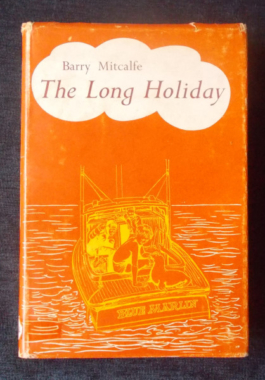- Sorry, this product is unavailable.
-

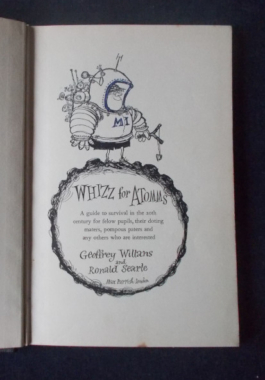 Nigel Molesworth - St. Kustards - offers a guide to survival for the 20th century with advice on how to obtain More Culture and a Cleaner Brane; The Peason-Molesworth atommic pile; End of term marks; The Molesworth Report on Masters and a discourse on the topic that all books which boys hav to read are wrong. Illustrated by Ronald Searle. All misspellings contained herein are Nigel's own.
Nigel Molesworth - St. Kustards - offers a guide to survival for the 20th century with advice on how to obtain More Culture and a Cleaner Brane; The Peason-Molesworth atommic pile; End of term marks; The Molesworth Report on Masters and a discourse on the topic that all books which boys hav to read are wrong. Illustrated by Ronald Searle. All misspellings contained herein are Nigel's own. -

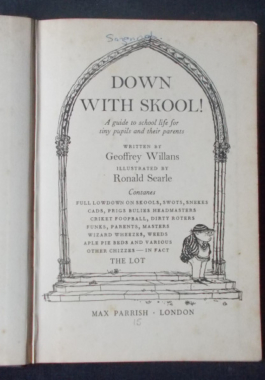 Meet Nigel Molesworth and his 'grate frend' Peason, veteran pupils at St. Kustards School for Boys. Between them they cover all aspects of boarding school life: Masters At a Glance, Kanes I Have Known; Skool Prospectus; How to Torture Parents and other survival skills. This volume 'contanes the full lowdown on skools, swots, sneeks, cads, prigs, bulies, headmasters, criket, foopball, dirty roters, funks, parents, masters, wizard wheezes, weeds, aple pie beds and various other chizzes...' (That's Nigel's and Pearson's spelling, by the way - not mine...) Written specifically as a 'guide to school life for tiny pupils and their parents' From the creators of St. Trinians and with hilarious illustrations by Ronald Searle.
Meet Nigel Molesworth and his 'grate frend' Peason, veteran pupils at St. Kustards School for Boys. Between them they cover all aspects of boarding school life: Masters At a Glance, Kanes I Have Known; Skool Prospectus; How to Torture Parents and other survival skills. This volume 'contanes the full lowdown on skools, swots, sneeks, cads, prigs, bulies, headmasters, criket, foopball, dirty roters, funks, parents, masters, wizard wheezes, weeds, aple pie beds and various other chizzes...' (That's Nigel's and Pearson's spelling, by the way - not mine...) Written specifically as a 'guide to school life for tiny pupils and their parents' From the creators of St. Trinians and with hilarious illustrations by Ronald Searle. -
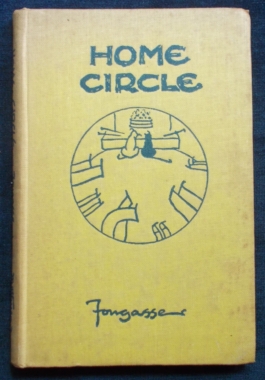
Home Circle: Fougasse
$15.00A wonderful little book of cartoons on the joys of everyday life in wartime, with some good sly social comments on the little human pomposities of the time. -
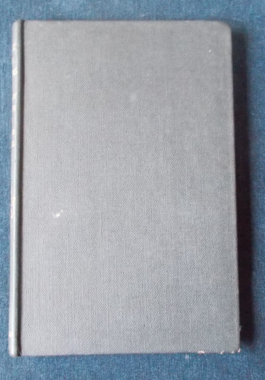
 Welcome to St. Kustards and your tour guide, Nigel Molesworth and his 'grate frend' Peason. This is the boys' version of St Trinians and from the same creators. Illustrated lavishly by the irrepresible Ronald Searle. Chapters include How to Be a Young Elizabethan and How to Survive in the Atommic Age - with a 'guide to gurls'.
Welcome to St. Kustards and your tour guide, Nigel Molesworth and his 'grate frend' Peason. This is the boys' version of St Trinians and from the same creators. Illustrated lavishly by the irrepresible Ronald Searle. Chapters include How to Be a Young Elizabethan and How to Survive in the Atommic Age - with a 'guide to gurls'. -

The Bondman: Hall Caine
$10.00First published in the late 1890s, this is the tale of half-brothers Michael and Jason. Jason is sworn to avenge the wrongs done to their father; Michael is sworn to rectify them. The story moves from the Isle of Man to Iceland. On the way the half brothers encounter love, personal upheaval, political revolutions and natural disasters. This is not only a literal journey - it is also a spiritual journey. -
 The story of a little French orphan who is spotted by a wealthy socialite playboy who offers, on a whim, to sponsor her care at the orphanage. But she never sees him - all she has seen is his long shadow on the wall and she calls him 'Daddy Long-Legs'. She writes him letters of gratitude; he never writes back, yet continues to sponsor her. When she goes to college, they finally meet. This book was made into a very popular film with Fred Astaire and Leslie Caron.
The story of a little French orphan who is spotted by a wealthy socialite playboy who offers, on a whim, to sponsor her care at the orphanage. But she never sees him - all she has seen is his long shadow on the wall and she calls him 'Daddy Long-Legs'. She writes him letters of gratitude; he never writes back, yet continues to sponsor her. When she goes to college, they finally meet. This book was made into a very popular film with Fred Astaire and Leslie Caron. -
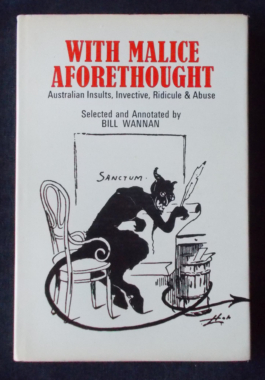 Australian insults, invective, ridicule and abuse as only Australians could invent! From lords and ladies, governors and generals and even Ned Kelly - on all topics from Explosive Explorers to Royalty Rebuked. Here is some of the real Australian history, some of it in satirical verse, such as Wowsers by Anon, 1911: For six days long they lie and cheat...And on the seventh at Church they meet...To render to the Lord their God...A threepenny bit, with a holy nod; And then they part with unctuous smile - and a prayer to prosper the next weeks guile. Or this, spotted on the headstone of an old-time Murray River settler's grave: He revelled 'neath the moon; He slept beneath the sun; He lives a life of going-to-do - And died with nothing done.
Australian insults, invective, ridicule and abuse as only Australians could invent! From lords and ladies, governors and generals and even Ned Kelly - on all topics from Explosive Explorers to Royalty Rebuked. Here is some of the real Australian history, some of it in satirical verse, such as Wowsers by Anon, 1911: For six days long they lie and cheat...And on the seventh at Church they meet...To render to the Lord their God...A threepenny bit, with a holy nod; And then they part with unctuous smile - and a prayer to prosper the next weeks guile. Or this, spotted on the headstone of an old-time Murray River settler's grave: He revelled 'neath the moon; He slept beneath the sun; He lives a life of going-to-do - And died with nothing done. -
 A very complete collection of Aussie folk songs: Convicts, bushrangers, goldminers; lawyers and law breakers; teamsters, drovers, stockmen, shearers and strikers. A tribute to the men who boozed, battled, bludgeoned, bullied and blarneyed their way through the first century of Australia. Illustrated by the author.
A very complete collection of Aussie folk songs: Convicts, bushrangers, goldminers; lawyers and law breakers; teamsters, drovers, stockmen, shearers and strikers. A tribute to the men who boozed, battled, bludgeoned, bullied and blarneyed their way through the first century of Australia. Illustrated by the author. -
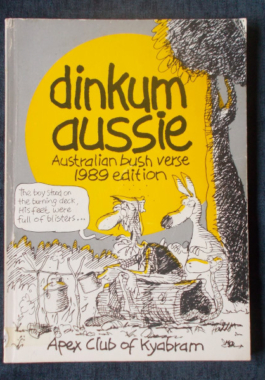 Includes such Aussie gems as: Picking Out the Melon Pips; The Bush Wedding; The Old Bark Hut; Ya' Stupid Galah!; Much Ado About a 'Roo; Anzac Day and many more unique true-blue poems. The Apex Club of Kyabram issued the first 'Dinkum Aussie Award' for Bush Verse in 1988 and were so pleased at the response, they went for it and 'had another go' in 1989. Who knows - some of the coves in here might be famous writers by now!
Includes such Aussie gems as: Picking Out the Melon Pips; The Bush Wedding; The Old Bark Hut; Ya' Stupid Galah!; Much Ado About a 'Roo; Anzac Day and many more unique true-blue poems. The Apex Club of Kyabram issued the first 'Dinkum Aussie Award' for Bush Verse in 1988 and were so pleased at the response, they went for it and 'had another go' in 1989. Who knows - some of the coves in here might be famous writers by now! -
 Horace Wheeler is handsome, quick-witted and poor. Horace's one desire is to be in love, which leads him into proposing. Aunt Jane is a sincere, kind-hearted Christian widow who's not always appreciated for her words of wisdom or her little "sermons". Those little sermons interfered with the good times Horace has with the less serious young people he keeps company with and his unfailing sense of humor and easy manner makes him a favorite in his crowd. But then the Civil War breaks out and Aunt Jane's prayers follow Horace after he enlists to fight - and his experiences make him become a different man; not only physically but spiritually.
Horace Wheeler is handsome, quick-witted and poor. Horace's one desire is to be in love, which leads him into proposing. Aunt Jane is a sincere, kind-hearted Christian widow who's not always appreciated for her words of wisdom or her little "sermons". Those little sermons interfered with the good times Horace has with the less serious young people he keeps company with and his unfailing sense of humor and easy manner makes him a favorite in his crowd. But then the Civil War breaks out and Aunt Jane's prayers follow Horace after he enlists to fight - and his experiences make him become a different man; not only physically but spiritually. -
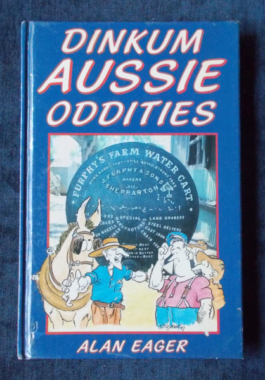 A guide book for those things that could only be found in Australia: Snake Gully's 'Dad and Dave' statues near Gundagai; the famous 'Dog on the Tuckerbox'; The Big Cod at Tocumwal and the Big Yabby at Wentworth; The Big Sapphire near Anakie and much more...and not forgetting the infamous 'Furphy.' This book is definite proof that Australians really are a 'weird mob'. Illustrated with cartoons and colour and black and white photographs.
A guide book for those things that could only be found in Australia: Snake Gully's 'Dad and Dave' statues near Gundagai; the famous 'Dog on the Tuckerbox'; The Big Cod at Tocumwal and the Big Yabby at Wentworth; The Big Sapphire near Anakie and much more...and not forgetting the infamous 'Furphy.' This book is definite proof that Australians really are a 'weird mob'. Illustrated with cartoons and colour and black and white photographs. -
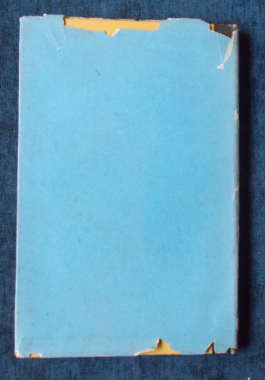
 First published in 1950 and costing 9/6, this book addresses Australia's Fuel and Power problem and studies the provision of energy and its effect on national development. It also covers the production of oil from coal and the prospect of finding oil in Australia. Illustrated with maps and diagrams.
First published in 1950 and costing 9/6, this book addresses Australia's Fuel and Power problem and studies the provision of energy and its effect on national development. It also covers the production of oil from coal and the prospect of finding oil in Australia. Illustrated with maps and diagrams. -


'Henry Handel Richardson’s' debut, published in London in 1908, is set in the music scene of Leipzig, a cosmopolitan centre for the arts drawing students from around the world - among them Maurice Guest, a young Englishman, who falls helplessly in love with a 'highly unsuitable' Australian woman, Louise Dufrayer. The novel was deemed too controversial to be published as Richardson intended, and she was forced to cut twenty thousand words from the original manuscript and tone down its language.
-
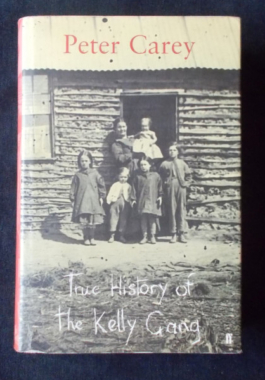
I lost my own father at 12 yr of age and know what it is to be raised on lies and silences my dear daughter you are presently too young to understand a word I write but this history is for you and will contain no single lie may I burn in Hell if I speak false....The legendary Ned Kelly speaks for himself, scribbling his narrative on errant scraps of paper in semi-literate yet magically descriptive prose as he flees from the police. To his pursuers, Kelly is nothing but a monstrous criminal, a thief and a murderer. To his own people, the ordinary Australians, the bushranger is a hero, defying the authority of the English to direct their lives. Indentured by his bootlegger mother to her lover, a famous horse thief, Ned saw his first prison cell at 15 and by the age of 26 had become the most wanted man in the wild colony of Victoria, taking over whole towns and defying the law until he was finally captured and hanged. There is almost a sensation of Ned speaking from beyond the grave.
-

 Hudson explores the forces responsible for bringing about the Renaissance, which he describes as...the West's transition from the medieval to the modern world. Voyages of discovery, inventions, the revival of classical learning and the advent of science contribute to the intellectual upheavals of this creative period which are reflected in its literature and art. Hudson focuses on the one thread of continuity which he sees as both the seed and the fruit of this exciting era: the awakening of secular humanism and the emergence of the individual. Chapters: The Renaissance In General; The Age Of Invention And Discovery; The Revival Of Learning; The Renaissance In Religion: The Reformation; Science And Philosophy; Art, Literature And Education. Illustrated.
Hudson explores the forces responsible for bringing about the Renaissance, which he describes as...the West's transition from the medieval to the modern world. Voyages of discovery, inventions, the revival of classical learning and the advent of science contribute to the intellectual upheavals of this creative period which are reflected in its literature and art. Hudson focuses on the one thread of continuity which he sees as both the seed and the fruit of this exciting era: the awakening of secular humanism and the emergence of the individual. Chapters: The Renaissance In General; The Age Of Invention And Discovery; The Revival Of Learning; The Renaissance In Religion: The Reformation; Science And Philosophy; Art, Literature And Education. Illustrated. -
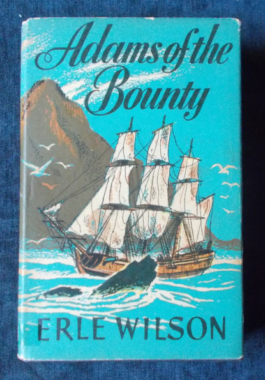 A novel based on historical fact, it tells the complete story of the part played in the Bounty mutiny by the man known as Alexander Smith - real name John Adams - his subsequent fate and that of the eight other mutineers together with their Maori women and friends who finally sailed from Tahiti in the Bounty in search of a secret sanctuary. The book offers adventure and excitement as well as the idea that the popular legend of Fletcher Christian as a hero and liberator and Bligh being branded as a bullying, inhuman monster may not be accurate; far from being an apologia for Bligh, it presents a logical, commonsense view of events that have intrigued historians since Bligh's first dispatches from Timor reached London. Cover art by Frank Norton.
A novel based on historical fact, it tells the complete story of the part played in the Bounty mutiny by the man known as Alexander Smith - real name John Adams - his subsequent fate and that of the eight other mutineers together with their Maori women and friends who finally sailed from Tahiti in the Bounty in search of a secret sanctuary. The book offers adventure and excitement as well as the idea that the popular legend of Fletcher Christian as a hero and liberator and Bligh being branded as a bullying, inhuman monster may not be accurate; far from being an apologia for Bligh, it presents a logical, commonsense view of events that have intrigued historians since Bligh's first dispatches from Timor reached London. Cover art by Frank Norton. -
 Published in 1973, this book has now become an interesting social and historical document. All things Australian are covered: our economic stability and strength; the vastness and sunshine of the land; our urban and industrialised life and our unique flora and fauna geography. Also covered are our political parties; our slang and currency; our living standards; private and public businesses; education; transport; arts, sports and amusements - all of which have developed with our unusual historical background.
Published in 1973, this book has now become an interesting social and historical document. All things Australian are covered: our economic stability and strength; the vastness and sunshine of the land; our urban and industrialised life and our unique flora and fauna geography. Also covered are our political parties; our slang and currency; our living standards; private and public businesses; education; transport; arts, sports and amusements - all of which have developed with our unusual historical background.


